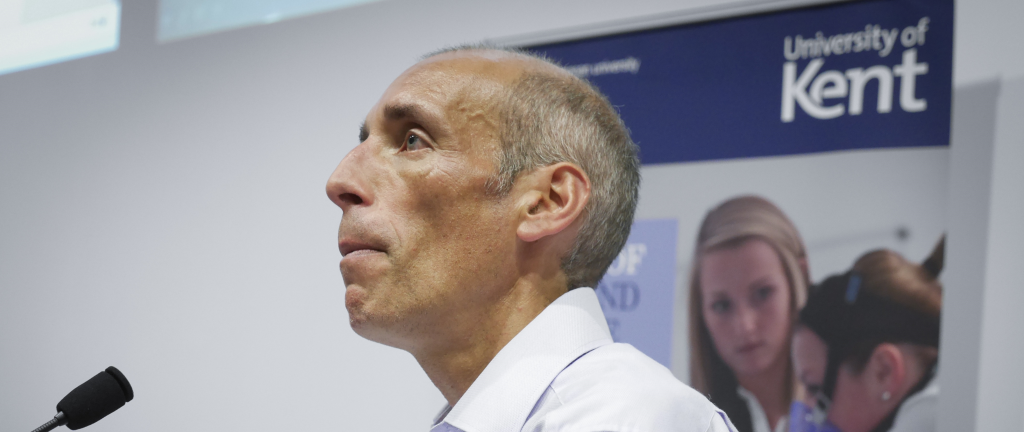Today’s blog is an account from the Head of School here at the University of Kent’s School of Sport and Exercise Sciences. Professor Louis Passfield has been head of SSES since 2007 and before this time worked as a sports scientist with British Cycling. Here’s what Louis has to say about his research on competitive cycling:
“When I was young I wanted to win the Tour de France. It was even the reason I went to university. My plan was to study sports science and apply this knowledge to my own bike training. During my time as a student I came to learn that the simple questions I posed about how to train effectively were not easily answered with sports science. Nonetheless upon graduating I made it to an Olympic training camp, dining at the same table as Sir Steve Redgrave no less. On this camp I can remember how I was impressed by the way the Great Britain cycling team dominated their bike race. But these were only young junior raw talents, yet they were powering away on their bikes in a manner I could not match. Fortunately, I was there as a sports scientist not a rider and I realised that for all my training I had more talent for sports science than cycling.
A quarter of a century later and I am privileged to still study and research the process of training. Today in the School of Sport and Exercise Sciences I am part of its Endurance Research Group, probably the largest group of its kind in the world. Some of the research that we have performed was unthinkable 25 years ago when I first started out in sports science. We have made riders contract their leg muscles by directly stimulating their brain. We did this to show that their brain rather than their legs can limit their performance. When we were concerned about riders’ legs we have investigated the composition of their muscles directly. In a recent study we managed to persuade 40 participants to let us biopsy a small sample of their muscle for analysis. Our 40 participants were delib-erately chosen to be young and old, trained and untrained cyclists.
By comparing results across these groups we found that the trained cyclists had more slow-twitch muscles. But that aging had no effect on this muscle composition. Further, the older cyclists had similar fitness to their young but untrained counterparts. Regular cycling had saved our older riders from the effects of more than 35 years of aging.
Bradley Wiggins wants to use the fastest pacing strategy possible in a time-trial. Should he produce a consistent effort throughout a race, go harder up the hills, and easier down, or vice versa? When Chris Hoy chooses his tactics in a sprint, he needs to decide whether to start his sprint early or late, whether to lead from the front, or to come from behind. Clearly getting Brad and Chris to go through all the different possible permutations before each race might not leave them in the best shape to compete afterwards. Our Endurance Research Group has developed an alternative method, which is to use a mathematical model instead. Now with the press of a button we can run any number of different computer simulations, changing riders, courses and tactics in order to determine the best options for Britain’s top cyclists to compete successfully.
Earlier this year the Tour de France held its Grand Depart in Leeds Yorkshire. As cycling is such a significant aspect of our research, staff and students of the School of Sport and Exercise Sciences were keen to celebrate the occasion. We organised a World Congress of Cycling Science in Leeds to coincide with the start of the Tour.
The conference provided a chance for our Endurance Research Group to showcase the best of its cycling related research. It also brought together cycling experts from around the world. We were privileged that many of the world’s leading sports scientists, cycling coaches and medical practitioners gathered in Leeds for our conference on the science behind cycling performance. The event was endorsed by international cycling’s governing body the UCI, and many of the Tour’s ProTeams such as Team Sky, Garmin-Sharp, Francais des Jeux, Movistar and Omega Pharma Quickstep were represented. Speakers at the conference included the Tour de France rider Nicholas Roche, Garmin-Sharp’s Team Director Charlie Wegelius (Garmin-Sharp), and former Italian national champion Marco Pinotti (BMC Pro Cycling Team).
Perhaps the highlight of our time in Leeds though was that we were also able to promote science and cycling at a local level too. Alongside the conference we ran an event for 150 primary school children, who came and took part in a number of science and cycling themed practical demonstrations and competitions. And the evening after the conference, as the Tour de France riders warmed up, we held an open evening for members of the public to come and learn more too. At these events I had to admit that I still did not have the answers to those simple questions about training that first motivated me to study sports. However, for the first time in my career, through the work of the Endurance Research Group I can see how cycling science might lead us in the right direction.”

